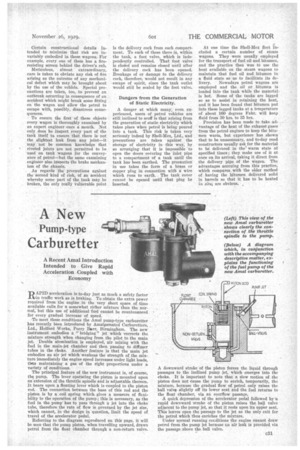A New
Page 69

If you've noticed an error in this article please click here to report it so we can fix it.
Pump-type
Carburetter
A Recent Amal Introduction Intended to Give Rapid Acceleration Coupled with Economy RAPID acceleration is to-day just as much a safety factor 1.11.fin traffic work as is braking. To obtain the extra power required from the engine in the very short space of time available calls for a somewhat richer mixture than the normal, but this use of additional fuel cannot be countenanced for every gradual increase of speed.
To meet these conditions the Amal pump-type carburetter has recently been introduced by Amalgamated Carburetters, Ltd., Llolford Works, Perry Barr, Birmingham. The new instrument embodies a "bridging" jet which .corrects the mixture strength when changing from the pilot to the main jet. Double atomization is employed, air mixing with the fuel in the main-jet chamber and then passing to diffuser tubes in the choke. Another feature is that the main jet embodies an air jet which weakens the strength of the mixture immediately the engine speed increases under light loads, tints maintaining a gas of the right proportions under a variety of conditions.
The principal feature of the new instrument is, of course, the pump. The lever operating the piston is mounted upon an extension of the throttle spindle and is adjustable thereon. -it bears upon a floating lever which is coupled to the piston rod. The connection between the base of this rod and the piston is by a coil spring which gives a measure of flexibility to the operation of the pump ; this is necessary, as the fuel in the pump has to pass through a jet into the choke tube, therefore the rate of flow is governed by the jet size, which cannot, in the design in question, limit the speed of travel of the accelerator pedal.
Referriug to the diagram reproduced on this page, it will be seen that the pump piston, when travelling upward, draws petrol from the float chamber through a non-return valve.
A downward stroke of the piston forces the liquid through passages to the inclined pump jet, which emerges into the choke. it is important to note that a slow motion of the piston does not cause the pump to enrich, temporarily, the mixture, because the gradual flow of petrol only raises the ball valve slightly off its lower seat and the fuel returns to the float chamber, via an overflow passage.
A quick depression of the accelerator pedal followed by m. rapid downward stroke of the piston raises the ball valve adjacent to the pump jet, so that it rests upon its upper seat. This leaves open the passage to the jet as the only exit for the petrol which thus enriches the mixture.
Under normal running conditions the engine cannot draw petrol from the pump jet because an air leak is provided via the passage above the ball valve.




























































































































